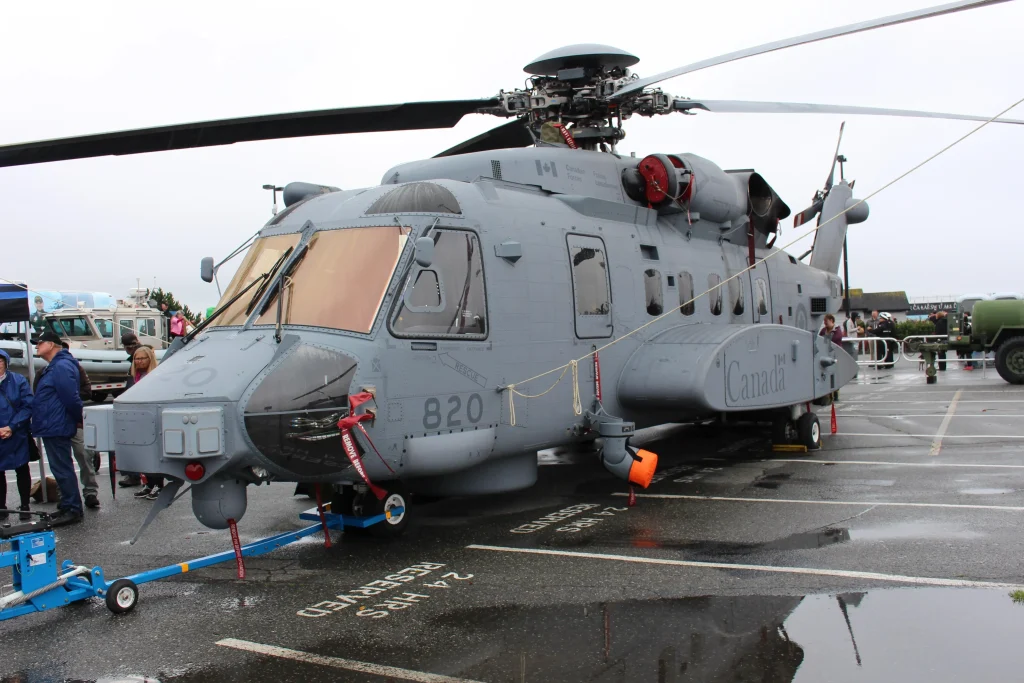The Canadian Cyclone helicopters, officially known as the CH-148 Cyclone, are a pivotal asset for the Royal Canadian Navy, providing essential air support in maritime operations. These advanced military helicopters represent a substantial investment of $5.8 billion and have significantly enhanced Canada’s capability for surface and subsurface surveillance, search and rescue, and anti-submarine warfare. However, the fleet faced operational setbacks recently when a critical shortage of spare parts led to a 27-day grounding, highlighting challenges in helicopter maintenance in Canada. Despite these issues, the Cyclone helicopters Canada maintains remain integral to national defense, as only one helicopter is currently operational out of the 26 deployed. As preparations for the complete return of the Cyclone helicopters to service continue, the military and defense officials are collaborating with manufacturers like Sikorsky to ensure the fleet’s long-term viability and safety.
The CH-148 Cyclone fleet stands at the forefront of Canadian military aviation, embodying a new era of maritime helicopter capabilities. Known for their versatility, these helicopters play a crucial role in supporting naval operations, conducting reconnaissance, and facilitating rescue missions for the Royal Canadian Navy. Challenges such as spare parts shortages have recently tested the operational readiness of these aircraft, underscoring the complexities of maintaining sophisticated helicopter systems in Canada. The ongoing collaboration between governmental agencies and industry partners aims to address these issues, ensuring that the Cyclone helicopters can effectively fulfill their mission requirements. As Canada continues to navigate its maritime challenges, the evolution and reliability of these military helicopters will be vital for national security and maritime safety.
Current Challenges Facing Canadian Cyclone Helicopters
The Canadian Cyclone helicopters, specifically the CH-148 model, are facing considerable challenges that have recently brought their operational status into question. Following a grounding period of 27 days in May due to a shortage of spare parts, the fleet’s reliability has drawn attention to ongoing maintenance issues. With only one helicopter operational at the moment, concerns about the aging hardware and necessary upgrades are becoming increasingly prominent. The situation worsened as reports emerged about certain components being used beyond their designated service life, heightening safety concerns for personnel and equipment alike.
Moreover, the Cyclone fleet is grappling with not just maintenance challenges but also technological limitations. The existing datalink systems are outdated, and sensor upgrades are overdue, which may impair the helicopters’ overall operational efficiency. As the Royal Canadian Navy helicopters are crucial to various missions, ensuring that the CH-148 Cyclone remains viable amidst these challenges is paramount. Continuous collaboration between military representatives and Sikorsky, the helicopter’s manufacturer, is essential for assessing the aircraft’s future within the context of modern naval operations.
The Importance of the CH-148 Cyclone in Military Operations
The CH-148 Cyclone plays a vital role in supporting Royal Canadian Navy operations. With its capabilities designed for surface and subsurface surveillance, search and rescue, and anti-submarine warfare, the Cyclone fleet is integral to Canada’s military strategy. The deployment of these maritime helicopters enhances situational awareness and response capabilities, particularly in coastal and oceanic environments. As Canada looks to bolster its maritime security, the Cyclone remains a crucial asset despite its current operational hurdles.
Historically, the Cyclone helicopters were introduced as a replacement for the aging CH-124 Sea King fleet, highlighting their importance in Canada’s military evolution. Despite the current maintenance and operational challenges, these helicopters are still expected to provide vital air support for the Navy. Military officials recognize the Cyclone’s capabilities and are committed to finding solutions to their operational difficulties. This commitment underscores the significance of maintaining and modernizing Canada’s fleet of military helicopters to ensure their effectiveness in safeguarding national interests.
The Future of Canadian Military Helicopters
As the Canadian military navigates the challenges surrounding its fleet of Cyclone helicopters, the future of these aircraft hinges on effective solutions to both maintenance and technological issues. The Department of National Defence (DND), in collaboration with Sikorsky and other industry partners, is conducting thorough assessments to ensure the longevity and operational effectiveness of the CH-148 Cyclone. This collaborative effort is critical, particularly as discussions about potential upgrades and replacements for critical parts are ongoing.
The concept of upgrading outdated systems within the Cyclone fleet aligns with broader trends in military modernization. As countries invest in advanced technologies, Canada must ensure its military helicopters, including the Cyclones, can meet contemporary operational demands. While there are concerns around the costs of necessary upgrades, the ongoing evaluation and planned assessments indicate a proactive approach by defense authorities to maintain and enhance the fleet’s capabilities. Future investments in technology will ultimately determine the role of Canadian military helicopters in both domestic and international operations.
Collaborative Efforts for Maintenance Solutions
The issue of helicopter maintenance in Canada extends beyond just the immediate need for spare parts for the Cyclone helicopters. The maintenance of the CH-148 fleet is a complex challenge that requires an ongoing dialogue between military officials, Sikorsky, and various suppliers. Many of the components used in these helicopters must meet strict military standards and service lifespans, necessitating meticulous attention during maintenance procedures. This collaborative approach is essential, especially given the reported scarcity of parts and the aging fleet’s complexities.
Additionally, there is a profound sense of urgency surrounding efforts to replace aging components and upgrade systems within the Cyclone helicopters. Despite the limitations faced by the current fleet, the combined knowledge and expertise of military and industry representatives could pave the way for innovative maintenance solutions. By leveraging technical advancements, Canadian military helicopters can enhance their operational readiness and safety, ensuring they remain effective assets in defending national interests against evolving threats.
The Transition from Sea Kings to Cylone Helicopters
The transition from the CH-124 Sea King helicopters to the CH-148 Cyclone models marked a significant change in Canada’s naval aviation capabilities. Announced by Paul Martin’s Liberal government in 2004, this decision was aimed at modernizing the fleet and improving operational efficiency within the Royal Canadian Navy. However, the CH-148 Cyclones have faced scrutiny over their reliability and parts shortages, raising questions about the success of this transition.
The Cyclone helicopters were expected to fill crucial gaps left by the aging Sea Kings, yet challenges in their production and maintenance have led to their characterization as an ‘orphan fleet’ by some military leaders. This term underscores the difficulty in sourcing parts and support for the Cyclones in their operational environment. As Canada continues to evaluate its military priorities and strategies, the lessons learned from transitioning to the Cyclone will be pivotal in guiding future procurements and fleet management considerations.
Comparative Analysis of Military Helicopter Models
In the realm of military aviation, comparative analysis of various helicopter models reveals the strengths and weaknesses of each fleet, including Canadian military helicopters such as the Cyclone and CH-146 Griffon. The CH-148 Cyclone is uniquely designed for maritime operations, making it indispensable for the Royal Canadian Navy. However, when comparing it to other helicopter models, it’s essential to consider operational versatility, maintenance needs, and overall mission effectiveness.
The CH-146 Griffon, for instance, has demonstrated its capability to operate in various contexts, though it does not share the same specialized design for maritime roles as the Cyclone. This distinction emphasizes the necessity of maintaining a well-rounded fleet that can adapt to both naval and land-based missions. Understanding these comparisons not only highlights the critical role of the Cyclone but also informs future procurement decisions and operational assessments of Canadian military helicopters.
Safety Concerns and Operational Protocols
Safety is a paramount concern when it comes to operating the Canadian Cyclone helicopters, especially following previous incidents. The tragic loss of a Cyclone in 2020 emphasized the need for rigorous operational protocols and comprehensive safety checks for all components. Ongoing investigations and safety assessments have led the DND to pause operations temporarily, ensuring that the fleet can return to the skies safely. Ensuring that mechanical parts are within their designated service life is crucial to mitigate risks associated with flying military helicopters.
Furthermore, adherence to operational protocols is vital in maintaining pilot and crew safety. The processes put in place to evaluate the Cyclone fleet’s readiness reflect robust military practices. As representatives from military and industry partnerships work closely to refine safety standards, the focus remains on safeguarding personnel while optimizing the functionality of helicopter operations across Canada.
Sikorsky’s Role in the CH-148 Cyclone Program
Sikorsky plays a pivotal role in the production and maintenance of the CH-148 Cyclone helicopters, ensuring adherence to military specifications and safety standards. As the manufacturer, Sikorsky is responsible for supplying spare parts and addressing any maintenance concerns that arise over the lifespan of the aircraft. Given the recent issues surrounding parts shortages and service life, Sikorsky’s collaboration with the DND is critical for the ongoing viability of the Cyclone fleet.
Moreover, Sikorsky’s expertise extends beyond initial manufacturing; it also encompasses support and upgrades during the operational lifetime of the helicopters. This includes addressing technological advancements, such as integrating modern avionics or enhancing systems capabilities. Ensuring that Sikorsky remains engaged in the lifecycle of the CH-148 Cyclone is essential in optimizing performance and meeting the Royal Canadian Navy’s evolving operational demands.
The Long-Term Viability of Canadian Military Helicopters
The long-term viability of Canadian military helicopters, including the CH-148 Cyclones, is contingent upon a combination of strategic investment, maintenance practices, and technological enhancements. With a total of 26 Cyclones in service, ensuring their readiness for various operational scenarios will require diligent planning and resource allocation. The recent grounding of the fleet highlights the importance of addressing maintenance backlogs and modernizing critical components to align with contemporary defense goals.
In light of the potential costs associated with upgrades and replacements for aging systems, the Canadian government must prioritize funding for military aviation projects. This investment is not solely a response to current challenges but a proactive measure to secure Canada’s maritime capabilities for the future. Achieving long-term viability for military helicopters, such as the Cyclone, will ultimately enforce Canada’s commitment to maintaining a robust and effective air support system for the Royal Canadian Navy.
Frequently Asked Questions
What issues have affected the Canadian Cyclone helicopters recently?
The Canadian Cyclone helicopters, specifically the CH-148 Cyclone fleet, were grounded for 27 days due to a shortage of spare parts. This issue arose from concerns that some components might have been used beyond their permissible lifespan, raising safety risks.
How many Cyclone helicopters does Canada have?
Canada possesses a total of 26 CH-148 Cyclone helicopters, which are primarily used for supporting the Royal Canadian Navy operations.
What roles do Canadian Cyclone helicopters serve?
Canadian Cyclone helicopters serve various roles, including surface and subsurface surveillance, search and rescue operations, and anti-submarine warfare, crucial for Royal Canadian Navy missions.
What recent actions have been taken regarding the safety of the Cyclone fleet?
Following safety concerns, the Commander of 1 Canadian Air Division temporarily halted operations of the CH-148 Cyclone fleet to inspect critical components. The suspension was lifted once safety checks were confirmed.
Are there any ongoing upgrades or maintenance issues with the Canadian Cyclone helicopters?
Yes, the Canadian Cyclone helicopters are facing challenges related to outdated datalink systems and overdue upgrades for sensors. The Department of National Defence (DND) is currently assessing these upgrades.
What is the operational status of the CH-148 Cyclone helicopters currently?
As of now, one Cyclone helicopter has returned to operational status, and efforts are in place to reintroduce the entire fleet back into service.
Why were the CH-148 Cyclone helicopters introduced in Canada?
The Cyclone helicopters were introduced to replace the aging CH-124 Sea King fleet, a decision announced in 2004 to enhance the capabilities of the Royal Canadian Navy.
What are the concerns regarding parts availability for Canadian Cyclone helicopters?
Concerns have been raised that many suppliers are reluctant to produce parts for the Cyclone helicopters, leading to operational difficulties and maintenance challenges, which some refer to as the fleet being an ‘orphan fleet’.
What tragic event involved a Canadian Cyclone helicopter in recent years?
On April 29, 2020, a Canadian Cyclone helicopter tragically crashed into the Ionian Sea, resulting in the deaths of six Canadian Armed Forces members during a routine operation.
How does the performance of the Cyclone compare to other military helicopters in Canada?
The CH-148 Cyclone is unique in its capability to support maritime operations for the Royal Canadian Navy, whereas other military helicopters, like the CH-146 Griffon, haven’t taken on this specific role.
| Key Points | Details |
|---|---|
| Grounding of Cyclone Helicopters | The Canadian military’s Cyclone helicopters were grounded for 27 days in May due to a shortage of spare parts. |
| Current Operational Status | As of now, only one Cyclone helicopter is operational. |
| Fleet Size | Canada has a total of 26 Cyclone helicopters. |
| Cost of Fleet | The total investment for this fleet is reported to be $5.8 billion. |
| Operations | The Cyclones provide air support for the Royal Canadian Navy, including search and rescue and anti-submarine warfare. |
| Temporary Operations Halt | Operations were temporarily halted by the Commander of 1 Canadian Air Division on May 1 due to spare parts concerns. |
| Safety Concerns | Parts were reportedly used beyond their service life, prompting a suspension of flight operations. |
| Future of Fleet | Military and government bodies are assessing the future capabilities and necessary upgrades for the Cyclone helicopters. |
| Accidents | One Cyclone crashed in 2020, resulting in the death of six servicemen. |
Summary
Canadian Cyclone helicopters play a crucial role in supporting the Royal Canadian Navy, despite recent challenges, including a 27-day grounding due to spare part shortages. With only one operational helicopter currently, it is essential for the military to address the ongoing safety and upgrade concerns to ensure these vital aircraft can continue their role in national defense. The future of the Cyclone fleet remains uncertain, but collaboration between military officials and manufacturers is underway to assess and enhance its capabilities.



